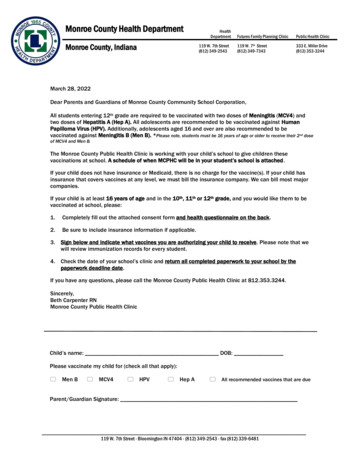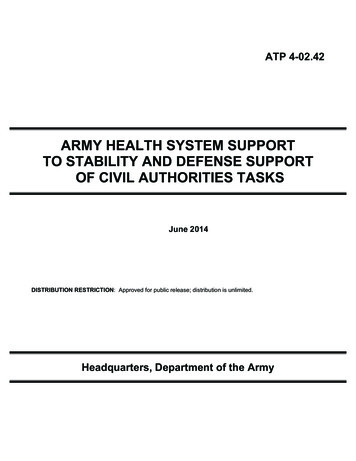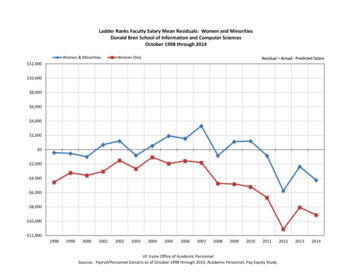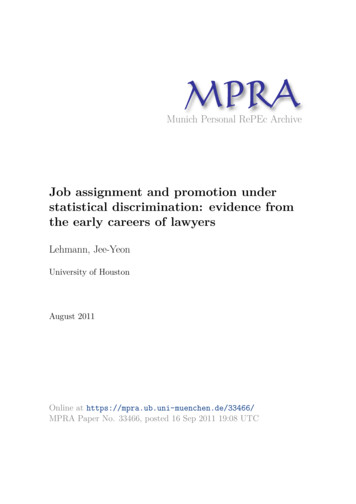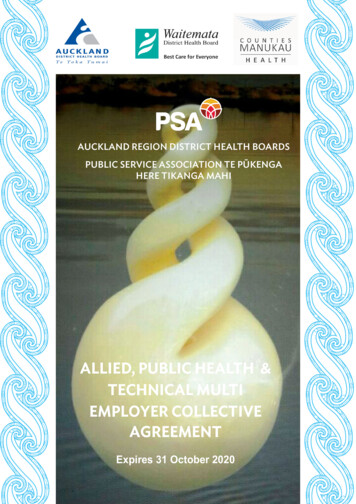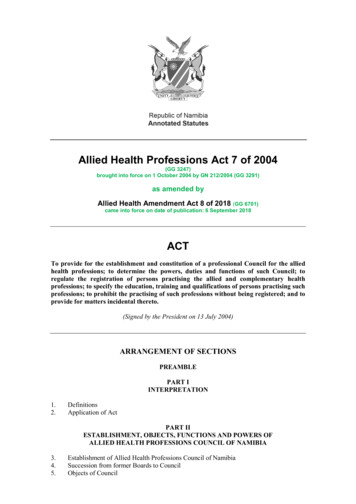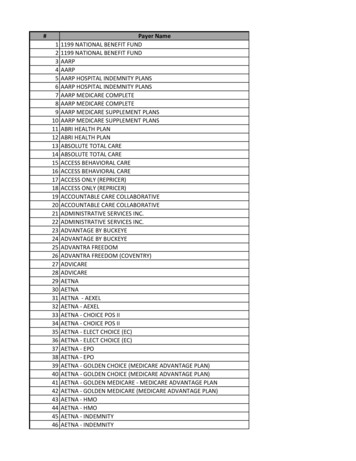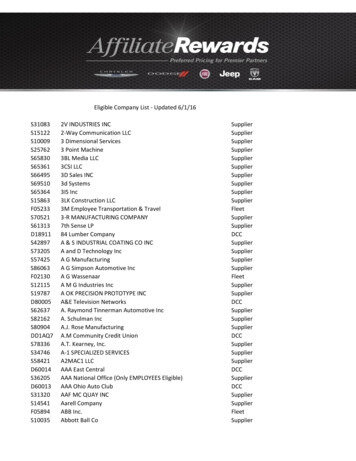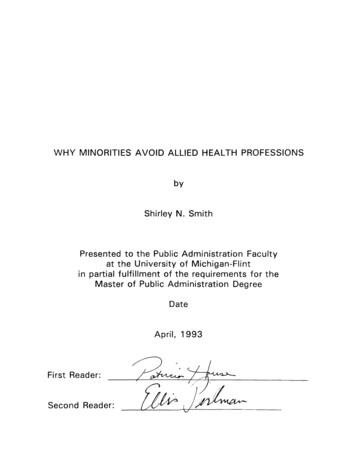
Transcription
W H Y M IN O R ITIE S A V O ID ALLIED HEALTH PROFESSIONSbyShirley N. SmithPresented to the Public Administration Facultyat the University of Michigan-Flintin partial fulfillment of the requirements for theM aster of Public Administration DegreeDateApril, 1 9 9 3First Reader:Second Reader:
A ckno wledgements/ would like to acknowledge Steve Nikoloff, Director o fResearch, Flint Board o f Education; Mrs. Bessie H. Straham,Principal, Northwestern High School; Mr. Glenn Kelly, EconomicsInstructor, Northwestern High School; Mr. Doug Weir, Principal,Genesee Area Skill Center; Ms. Phyllis Jones, Facilitator, GeneseeArea Skill Center; Mrs. Marilyn Reeder, Instructor, Genesee AreaSkill Center, Mrs. Car/otta Simons-May, Instructor, Genesee AreaSkill Center.This project would not have been completedwithout their express permission and cooperation.To the students at Northwestern High School and GeneseeArea Skill Center who took time from a busy and hectic classschedule to complete the questionnaires, / express m y deepestappreciation. Without them there would be no data.Last but not least / would like to thank Ms. Deb Millingsfor her clerical assistance. This study would have not been completed withouther assistance.
TABLE OF CONTENTSAcknowledgementsivTable of ContentsiiAbstract1Overview of the yDefinition:Allied Health Professions910Methodology12Limitations14Survey Respondents19Discussion of 1References43Appendices45Survey Instrument51
ABSTRACTThe participants in this study supply some of the reasons minorityindividuals do not apply, enter, or graduate from an "Allied Health Profession."Persons w ho w ere chosen for this project represent minority individuals at thehigh school level w ho may or may not have considered entering a healthcarevocation.The individuals w ere enrolled at Northwestern Community High Schoolw here a traditional curriculum of m ath, science and english is offered as themain courses of study in preparation for attendance at a four year institution.The Genesee Area Skill Center is a "vocational/technical" institution w ith thespecific goal of producing an individual prepared to enter the work force upongraduation.Students at this institution w ere enrolled in a curriculum gearedto a healthcare profession, i.e., nursing or medical assistant.This w as a one time only study w ith participants providing answers toa survey prepared by the evaluator to ascertain their interest in a healthcareprofession and the reasons they choose the specific educational institution they1
The Director of Research for the Flint Board of Education and theprincipals of the tw o schools, Northw estern Com m unity High School and theGenesee Area Skill Center, agreed to allow the students to participate in thissurvey.An extensive review of the literature does not yield any evidence of thecause of the lack of people of color in the aforem entioned arena.It w as thisspecific lack of evidence which drove the desire to find the similarities,differences betw een the institutions and the tw o sets of individuals whichwould dem onstrate the reasons minorities do/do not w an t to become membersof specific Allied Health Professions. Therefore, it w as the author's belief thatonce these reasons w ere uncovered, based on these deductions, measurescould be taken to encourage minority individuals to seek entry into healthcaresciences/professions.2
OVERVIEW OF THE PROBLEMBy the year 2 0 0 0 , some of the fastest growing professions-RadiologicTechnologists, Respiratory Therapists--wil! need to increase their ranks by 4 1 6 6 % . Because the "proportions of blacks and Asians will increase while whiteswill decrease,"1 it is imperative that something be done to increase thepresence of minority individuals in the Allied Health Professions.Hence thestudy to disclose the reasons for the lack of minority representation. . S . Labor Departm ent. Occupational Outlook Quarterly. Fall, 1 9 8 7 , 3 1 (3 ), 4 -1 43
adiographers),RespiratoryTherapists,Occupational Therapists--will need to increase their ranks by 4 1 -6 6 % . Thesepositions will more than likely be filled by an individual from the "minority"population;more specifically,Hispanic,Black or A sian.2Accordingtodemographics, "the hispanic labor force will rise from 8 million in 1 9 8 6 to 14million in 2 0 0 0 .The proportions of blacks and Asians will increase whilew hites will decrease."3At present there is a dearth of these individuals in the Allied HealthProfessions which either increases or decreases depending on which professionyou choose to examine.Although there have been repeated requests andexpressions of concern over the lack of minority individuals in these health careprofessions, there is still a marked absence of people of color in the enrollment,participation, and graduation from these arenas.A thorough search of the literature reveals that nursing has begun to riseto the challenge of increasing minority representation. The University of2U. S. Labor Departm ent, Occupational Outlook Quarterly. Fall, 1 9 8 7 , 3 3 (3 ), 5-1 1; 2 9 -3 7 .3U.S. Labor Departm ent, Occupational Outlook Quarterly, Fall, 1 9 8 7 , 3 1 (3 ), 4 -1 44
Southwestern Louisiana used a grant to increase minority participants in a BSNprogram.4Anderson states thatrecruitment of minorities into nursing should include a"multicultural perspective" which views the minority student asa "cultural asset."5In an article about "Understanding the Patient: The Need for Minoritiesin Clinical Laboratory Science," "anecdotal" evidence cites counseling againstdifficult academic courses as a reason for lack of recruitment for minorities.6Others cite "lack of role ityoftheseactions/statem ents are not questioned by the author. However, they lack onecomnmon denominator: input from the minority community. They also fail toaddress the primary concern:w hy minorities avoid allied health professions.To the author, this lack of evidential support shouldbe corrected and4Des Orm eaux,S, Redding, E.A. GAIN: Successful Recruitment and Retention Programfor Disadvantaged Students. Journal of Nursing Education. Nov. 1 9 9 0 , 2 9 (9 ), 4 1 2 -4 1 4 .5Anderson, J. Nursing Students: Minority Recruitment and Retention. Nurse Educator.Septem ber/October 1 9 9 1 , 1 6 (5 ), 3 8 -3 96Gore, M .J. Understanding the Patient: The Need for Minorities in Clinical LaboratoryScience. Clinical Laboratory Science, May/June 1 9 9 0 ,3 ( 3 ) , 1 4 2 -1 4 8 .7Martin, B.G., Woods, K.A., Holiday, I.the M T Shortage.Minority Recruitment: An untapped resource for5
substantiated by going directly to the individuals that have been discussed--theminority population.To obtain the view point of said population, the following groups w eresampled:1.Students at Northwestern Community High School, a"traditional"8 high school formerly identified as a"m agnet"9 school for individuals w ho were interested inpursuing a career in the healthcare arena.The magnet program was dropped in 1 9 9 0 , but there wereresidual students enrolled at the high school who werepursuing health careers.2.Students from the Genesee Area Skill Center, a"vocational/technical" training school, dedicated toteaching employable skills to be used prior to andimmediately upon graduation.These groups of students represented minorities who would or couldcontinue their education in colleges and universities after graduation from highschool. They also represented minorities who would, could, or might seekem ployment immediately upon graduation from high school, based on skillsattained during high school.8Traditional in the sense that curriculum is geared towards a College Prep or academicallydifficult curricula such as math or science.9A school whose curriculum is geared to specific subjects to draw students who areinterested in a particular field of study such as the sciences, arts, theater, etc.6
To ascertain w h at must be done to alleviate the problem of lack ofminorities in the Allied Health Professions, the purpose of this study w as toidentify the variables th at exist in and betw een a "traditional" educationalinstitution and a "vocational/technical" educational institution that influence aminority individual's decision to enter an Allied Health Profession, or thereasons for the students' lack of choice of an Allied Health Profession.Some of the issues that w ere explored to determine these variables w ereas follows:1.Do minorities understand the term , ALLIED HEALTHPROFESSIONS?2.Are there specific, identifiable variables endemic tothe minority populations in the aforementioned educationalsystems which persuade minorities to enter or not enterthe ALLIED HEALTH PROFESSIONS?3.Once the variables have been identified, are thereobstacles to the minority population which preventthem from pursuing ALLIED HEALTH PROFESSIONS?4.If the barriers are removed, will the minority populationsincrease their enrollment in the ALLIED HEALTHPROFESSIONS?5.Are there specific, major categories in the ALLIED HEALTHPROFESSIONS that appeal to minority populations morethan other professions?It w as these kinds of questions that led to the following hypotheses.7
HYPOTHESESBecause the reasons w ere unknown at the onset of this study, thehypotheses are as follows:H :1Considering the variables to be addressed in this study,there are major differences betw een traditional andvocational educational institutions which influence aminority's career decision.H :2Some of the reasons that are uncovered during thisexploration will result in a higher number of minoritiesenrolling in Allied Health Professions rather than otherprofessions.Having arrived at these reasons, they could be shared with the AlliedHealth com m unity and measures implemented which could/would be used toincrease the number of minorities enrolling in these areas.However, prior to any attem pt to prove/disprove these suppositions itwill be necessary to define tw o terms. To that end the following definitions willbe presented at the beginning of this paper:1.2.W hat is a minority?W hat are "ALLIED HEALTH PROFESSIONS?"8
DEFINITION: MINORITYThe United States Census Bureau only recognizes five (5) categories ofraces. They are W hite, Black, Asian or Pacific Islander, Am erican Indian, andOther. Hispanic refers to one's ability to speak Spanish and other cultural itemsand is not a racial category.Because there is only one group identified by the Census Bureau andonly one or tw o groups present in significant numbers in the Flint and GeneseeCounty School districts, the term M IN O R ITY refers to individuals of AfroAm erican and Mexican American descent--Afro-Am erican (Black) because theyrepresent the largest minority group ( 2 9 ,9 8 6 ,0 6 0 ),10 and Mexican-Am ericanbecause they are a rapidly growingpopulation w ith almost nonexistentrepresentation in healthcare or the ALLIED HEALTH PROFESSIONS.10U.S. Census Bureau, 1 9 9 0 Census9
DEFINITION:ALLIED HEALTH PROFESSIONSThe term ALLIED HEALTH PROFESSIONS includes 26 health-relatedgroups that assist, facilitate, and complement the work of physicians and otherhealthcare specialists.11Listed by profession they are:Radiographer {Radiologic Technologist)Medical TechnologistRespiratory TherapistMedical Laboratory Technician-Associate DegreeMedical AssistantRespiratory Therapy TechnicianSurgical TechnologistMedical Record TechnicianNuclear Medicine TechnologistRadiation TherapistEmergency Medical Technician-ParamedicOccupational TherapistMedical Record AdministratorPhysician AssistantCytotechnologistDiagnostic Medical SonographerMedical Laboratory Technician-CertificateHistologic Technician/TechnologistSpecialist in Blood Bank TechnologyMedical IllustratorSurgeon AssistantCardiovascular TechnologistThe major divisions recognized by the Comm ittee on Allied HealthEducation and Accreditation (CAHEA) are:Radiological SciencesLaboratory SciencesRespiratory Caren CAHEA accredited allied health education programs, facts and figures, 199110
These professions are accredited by CAHEA--part of the AmericanMedical Association (A M A ).The Com m ittee on Allied Health Education andAccreditation is recognized by the U. S. Secretary of Education and the Councilin Postsecondary Accreditation as a reliable authority of acceptable educationalquality for these professions.12These are professions that require education beyond high school and areexperiencing a shortage of minorities. Participants in this survey, it w as hoped,wouldprovidereasons for thelack of interestin theaforementionedoccupations. If w e can ascertain which particular areas do and do not hold aninterest for the minority student, perhaps the solution to increasing minorityenrollment in these areas will become more apparent.12Gupta, G. C. Student Attrition A Challenge for Allied Health Education Programs. Journalof American Medical Education. 1 9 9 1 , 2 6 6 (7 ), 9 6 3 -9 6 7 .11
M ETHODOLOGYThis research involved a w ritten questionnaire. The instrument w asdeveloped using factors described in the literature as "influential" in therecruitment of minority students for a variety of health related fields. A Likerttype scale w as prepared and based on these factors.The questionnaire was reviewed by professionals (pharmacist, nurse,drug counselor, instructors) for content and clarity. It w as then pre-tested on1 6 high school students outside the Genesee County area to obtain commentson relevance, clarity and ease of completion. Revisions were incorporated andsubmitted to the Human Subjects Committee at the University of M ich iganFlint for review of content and approval for use in determining factors relatedto deficient minority enrollment in Allied Health Careers. An adjustment riortoitsimplementation w ith participants.The questionnaire was then presented to separate classes of studentsat Northwestern Community High and the Genesee Area Skill Center. Studentsw ere informed orally and in writing of the author's intent to delve into thereasons for the shortage of minorities in the Allied Health Professions and theintent to conduct the aforementioned w ritten survey. A faculty member waspresent at all times.12
Fifty-three surveys w ere handed out to the students at Northw estern.W hen compiling the results of the survey, it w as discovered that nine of thesurveys w ere incomplete.Some questions w ere answered; others w ere leftblank. In some instances, only one question on each page w as answered. Onecan only attribute these actions to the vagaries of youth as no other explanationw as communicated to the author. To avoid skewing the results of this study,these survey replies w ere not included in the tabulated results.Forty-four out of 53 surveys were counted for Northwestern, a responserate of 8 8 % (4 4 /5 0 ). A t the Genesee Area Skill Center 29 out of 50 students,from three separate nursing and medical assistant classes, complied with therequest to complete the surveys.This resulted in a response rate of 5 8 %(2 9 /5 0 ).13
LIMITATIONSThe contents of the study w ere limited to the major divisions recognizedby CAHEA and the following representative professions:Radiographer (Radiologic Technologist)Medical TechnologistPhysical TherapistRadiation TherapistNursePhysicianThese professions:Radiographer (Radiologic Technologist)Medical TechnologistPhysical Therapistw ere chosen because of the author's perceived visibility and understanding ofthese occupations to the general public and therefore to the student populationof Flint.Radiation Therapist w as chosen because this particular modality is asubset of Radiologic Sciences and a wish on the part of the evaluator todiscover the extent to which it would be recognized as such by the minoritypopulation.Nurse and Physician w ere chosen because the author w as interested inthe number of individuals who would choose the profession(s) around whichthe Allied Health Professions are centered, require com m itm ent of four or moreyears of postsecondary education, extensive financial resources to attainprofessionalstatus,andw ereinstantly14recognizedasrequiringthese
com m itm ents to complete the educational process by prospective participantsin this survey.The educational requirements for the Allied Health Professions rangefrom an Associate's to a M aster's degree.In term s of the survey itself, the author had hoped to include threeseparate groups of minorities including those w ho have graduated and arepresently employed in an Allied Health Profession.Administrators at HurleyMedical Center, Northwestern Community High School and the Genesee AreaSkill Center w ere approached in order to obtain permission to speak w ith theirem ployees/students regarding the proposed project.Due to the rapid and continuous changes occurring in healthcareinstitutions, i.e., decrease in funding, downsizing of staff, non-replacement ofretirees, the resulting decrease in morale due to all of these events, it wasnecessary to abandon the group at Hurley Medical Center.A fter obtainingResearch,FlintBoardpermission fromofEducation,Mr. SteveMrs.Nickoloff,BessieDirector ofStraham ,Principal,Northw estern High School, and Mr. Doug W eir, Principal, Genesee Area SkillCenter, permission w as granted to conduct surveys at the aforementionedschools.15
Mrs. Straham requested that the survey be conducted in the Economicsclass because:1.There w as a larger cross-section of students interested in healthcareers and other disciplines.2.It w as a required class for graduation.Mr. W eir asked that I w ork through Ms. Phyllis Jones, Facilitator, at theSkill Center.Appointm ents w ere made w ith Mrs. Marilyn Reeder and Mrs.Carlotta Sim ons-M ay, Instructors in healthcare subjects (Medical Assistant andNursing). A fter lengthy discussion about the professions chosen as the focusof this study, all parties embraced the project .Therefore, the questionnaire surveys upon which this thesis is based islimited to the following individuals:1.Students at Northwestern High School w ho were inattendance in Economics Class (a required course) andwho may or may not have/had an interest in becoming anAllied Health Professional.Northwestern High School is a "traditional" school w ithmandatory courses in M athem atics, English, Science,Social Science, Physical Education, Fine Arts and ForeignLanguage or Occupational Education.116
2.Students at the Genesee Area Skill Center who w erecurrently enrolled in Allied Health Profession courses andmay or may not be employable at the end of theireducational activities in the field of their endeavor. Theyhave at least been exposed to a hospital or clinical setting.GASC students are pursuing "traditional" courses at areahigh schools, but attend the Skill Center tw o and one halfhours per day for vocational-technical courses during theirhigh school years that may result in immediateemployment upon graduation.1A t the tim e of this research there w ere 1 ,6 7 6 students enrolled atGenesee Area Skill Center, 4 6 8 of whom were minority individuals, and 1 1 2minorities are enrolled in the healthcare section of the curriculum .15 Of these,29 students w ho attended nursing and medical assistant classes taught by Mrs.Reeder and Mrs. Sim ons-May, and are representative of the minorities whoselect healthcare courses at the Genesee Area Skill Centers, agreed toparticipate in the survey.1Flint Public Schools guide for the Hiqh School Program of Instruction, Flint Public Schools,M ay, 1 9 8 5 In terview w ith Phyllis Jones, Facilitator, Vocational Education, Genesee Area SkillCenter, Flint, Michigan, 2 4 April 1 9 9 3 .17
At Northwestern High School there were 1 ,3 7 2 minority students(9 8 % )3 Of this number 4 4 individuals participated in the survey.BecauseEconomics is a required course for all students at the high school, theseparticipants represent the wide range of occupational interests of minoritystudents in the institution {Table 1)in te rv ie w w ith Bessie H. Straham, Principal, Northwestern Community High School, Flint,Michigan, 2 4 April 1 9 9 3 .18
Table 1SURVEY RESPONDENTSGROUP II(NW)N 44GROUP I(GASC)N 29YEAR OF TO TALS2944202543Asian01American-lndian102944TO TALSSEX:MaleRACE:M exican-Am ericanAfro-Am ericanTO TALSYEAR OF BIRTHChi-Square .7 6 0 6 1 6 1DF 3P 0 .8 5 8 9SEX:Chi-Square 1 8 .0 6 1 2 2DF 1P 0 .0 0 0 0RACE:Chi-Square 6 .2 7 8 9 3 6DF 5P 0 .2 8 0 0Using the Chi-Square analysis, w ith a significant factor of P .5 ,it w as evident that for this survey the minority population was composed19
mainly of Afro-Am ericans. The gender of the participant w as also significantbetw een the tw o groups: a mix of males and females at Northw esternCommunity High School w ith one male participant at GASC.Because therew as only one male participant at the Genesee Area Skill Center, the author hasto state that ALL the results from GASC represent female responses.20
DISCUSSION OF FINDINGSThere w ere 29 minority students who participated in this study at theGenesee Area Skill Center (GASC), and 4 4 at Northwestern Comm unity HighSchool. For the purposes of brevity, Genesee Area Skill Center will be referredto as GASC, Group I, and Northwestern Community High School will be NW ,Group II.Because this was a search for the variables and related components, itis essential that the questions and replies w ith significant values be included inthe thesis and presented to the reader. W e now begin that process.In any study it is essential for a participant to understand w hat is beingasked of him. When I refer to Allied Health Professions, I cannot assume thatthe individual knows w hat I am referring to. In order to determine w hether ornot minorities understoodw hat was meant by the term"AlliedHealthProfessionals," the first question on the survey addressed that issue. Hence inTABLE 2, you have a total of 73 individuals who replied to the query.21
QUESTION:The definition of Allied Health Professions is:26 healthrelated groups that assist, facilitate and com plem ent thew ork of physicians and other health care specialists.TABLE 2REPLYGROUP I(GASC)N 29GROUP II(NW)N 44Yes77No12Maybe416I do notknow1315No answer44Chi-Square 4 .7 9 6 5 1 7P 0 .3 0 8 8DF 4In dissecting this table, "maybe" indicated an uncertainty on the part ofthe participant to commit himself to an answer.that s/he did not know the answer.It lead the author to believeA "No answer" indicated the same.Therefore, when sheyou collapsed the categories, "no", "m aybe", "I do notknow", and "no answer" across BOTH groups for this question, there were 59individuals (22 in Group I, 37 in Group II), or 81 % of your population who hadlittle if any concept of the term Allied Health Professional.One would also have to say there was a higher degree of uncertaintyregarding the definition in the "traditional" institution.22
To ensure that lack o f knowledge of the definition of Allied HealthProfessions did not equal a lack of interest in healthcare careers, the extent ofinterest in the healthcare field w as addressed by this question:Pick one of the occupations listed below as your choice for the future.TABLE 3REPLY(Occupation)GROUP 1(GASC)N 29GROUP II(NW )N 44Physical SOther (Pleasestate theoccupation/profession of ICITY aryEducation01PhysicalEducation01Medical Assistant20Veterinarian10No Answer0Chi-Square 2 1 .7 0 1 0 6P 0 .0 0 1 4231DF 6
The significant factor of P 0 .0 0 1 4 makes it quite obvious that thesestudents have indeed considered a career in allied health professions at onetim e or another, and the collapsed results from both institutions indicate thatNurse (2 7 % ), physical Therapist (1 5 % ), Medical Technologist (7 % ), RadiologicTechnologist (7% ) are the careers of choice for future employment.Nevertheless, w ith the exception of Physical Therapist, the students atGASC showed a higher degree of interest in these fields than the NorthwesternHigh School students.The results of this survey also demonstrated the fact that the studentsat Northwestern w ere interested in careers which require several years ofpostsecondary education.If youkeep in mind thatNorthwesternfollows the"traditional"curriculum and the Genesee Area Skill Center emphasizes vocational training,the results w ere not surprising. Immediate results from an education is the goalof "vocational/technical" education; future results are the goals of "traditional"education.Also, Allied Health Professionals have historically been female.Although the gender bias at GASC was not examined, this bias could have beensuggestive of past occupational trends.24
W hen asked to pick all the reasons they "chose this occupation," thesignificant factor, P 4 7 {Table 4 A , Appendices, Page 4 8 ), was less striking,but the results w ere significant.An examination of the specific repliesdemonstrates that the choices w ere almost equal, w ith the w idest range ofdisagreement betw een the tw o groups being in the "I know w hat I w ant to do,""other", and "I know w hat this professional does" categories. These responsesindicated the participant had made some definite career choices,, the careerchoice appealed to him, the occupation attracted his interest, and there were"other" factors which enter into a career choice for minorities.To examine one of the "other" fa c to rs -w h o influences the minorityindividual's career choice(s)--the students w ere asked this specific question{Table 7, Appendices, Page 50).Although the calculated significant factor of .4 6 7 6 was only .03 largerthan the significant factor of P . 5 , it w as apparent from the numbers thatthere w as a high probability of influence on career choice for each group fromthe individuals listed.If you examine the replies, Group II was more adamant in their rejectionof "influence".This could be connected to the fact that these students hadalready chosen "other occupations" and they "know w hat I w ant to do.,"(8 2 % )25
One should note the disparity betw een institutions in the rolem odel/mentor influence. It appears that role models may play a larger role inthe "traditional" setting than they do in the "vocational" setting. A separatestudy would be necessary to determine the exact reason for this incongruity,but it should be noted.The evaluator continued to explore influential individuals w ith thefollowing query:QUESTION:If I had a pleasant experience w ith someone in the healthcare field, I would consider entering that profession.TABLE 4REPLYGROUP I(GASC)N - 29GROUP II(NW)N 44Yes1512No212Maybe1018Other(TOTAL)22Chi-Square 6 .9 4 1 7 5P 0 .0 7 2 7DF 3W ith P 0 .0 7 , it can be accurately stated that a person who is alreadyin a healthcare profession can influence a minority individual w ith a pleasantinteraction but there was disparity between the tw o groups, and w e mustapproach this conclusion cautiously.26
5 2 % said yes at GASC.2 7 % said yes at Northw estern."No" response was significantly stronger than Group I's.Group M's(2 7 % versus 6% )How ever, the undecided votes w ere equally strong; 3 4 % "maybe" at GASC,and 4 1 % at Northwestern.Perhaps the most positive w ay to interpret this information is to suggestthat the individual participants had not formed any concrete opinions but wereopen to positive pressure from individuals within the healthcare field if theyw ere exposed to a "pleasant experience".This leads us to a final attem pt to settle thequestionof rolemodel/influence exerted by a health care professional. The following questionwas posed:QUESTION:If I knew someone that w as in a particular healthcare field andfelt I could turn to them for guidance when I needed it, I wouldchoose a healthcare profession.TABLE 5REPLYGROUP I(GASC)N 29GROUP II(NW)N 44Yes1411No29Maybe819I do notknow45Other(Pleasespecify)(TOTALS)10Chi-Square 9 .0 9 7 9 7 6 7P 0 .1 0 5 227DF 5
It became clear that a professional already in the field could influence aminority individual's choice of career, but that the "traditional" student wasmore resistant to this influence than the "vocational/technical" individual.It occurred to the author that guidance counselors at these institutionswould/could play an enormous role in influencing the students' future courseof study.school.Officially, students at GASC received counseling from their homeThey saw a counselor at Genesee Area Skill Center if they need tohave a class changed or felt the need to talk to som eone.17A t Northwestern, there is no "set requirement but it is standardprocedure to have a counselor see the student when they sign up forclasses."18However, the results obtained from the survey are ambiguous at best(Table 4 A , Appendices, Page 4 9 ).According to the students,schoolcounselors w ere seen by the students on the average of every three months.One can also state that they are seen at the beginning of each term/semester.However, from the students' point of view , it w as clear that no real differenceexistedbetw een the institutions as to the number of times a studentsaw /interacted w ith their counselor. In terview w ith Phyllis Jones, Facilitator, Vocational Education, Genesee Area SkillCenter, Flint, Michigan, 2 4 April 1 9 9 3 . In terview w ith Mr. Stableford, Assistant Principal, Northwestern High School, 24 April1993.7o
It was also clear that there w as no set pattern within the institut
Histologic Technician/Technologist Specialist in Blood Bank Technology Medical Illustrator Surgeon Assistant Cardiovascular Technologist The major divisions recognized by the Committee on Allied Health Education and Accreditation (CAHEA) are: Radiological Sciences Laboratory Sciences Respiratory Care

